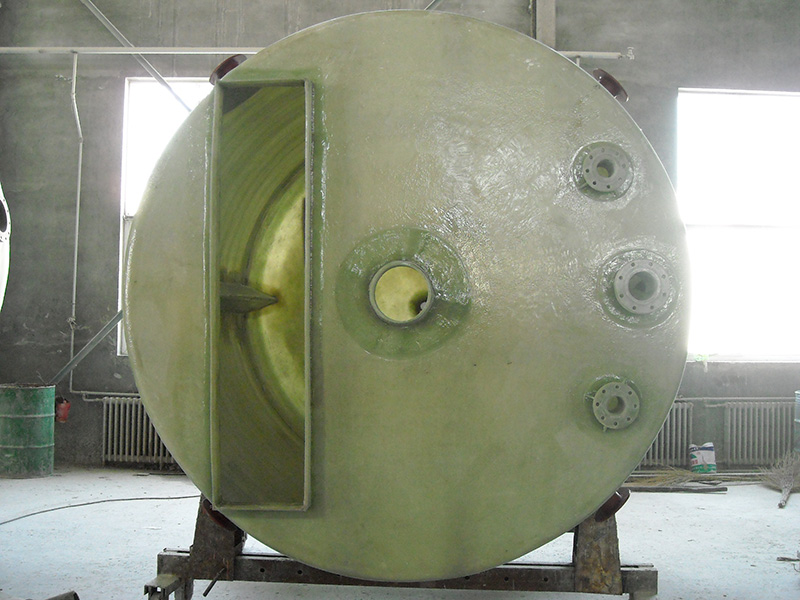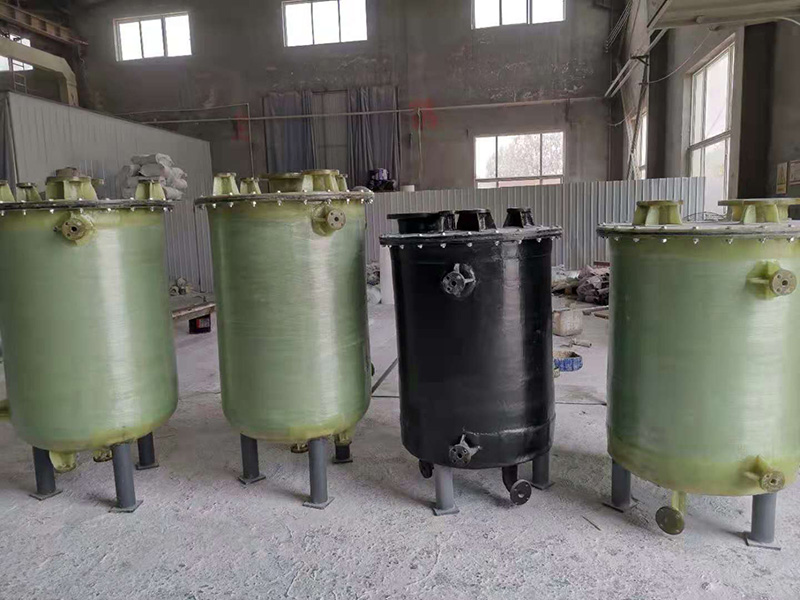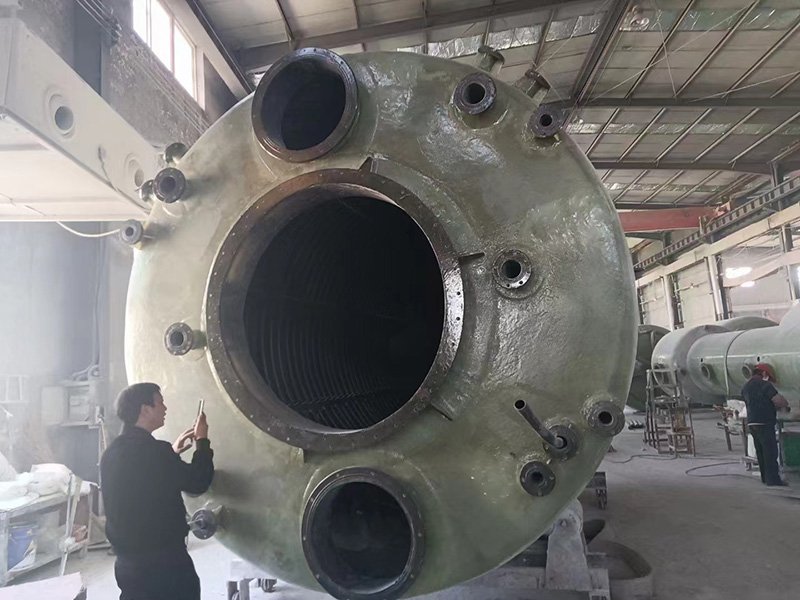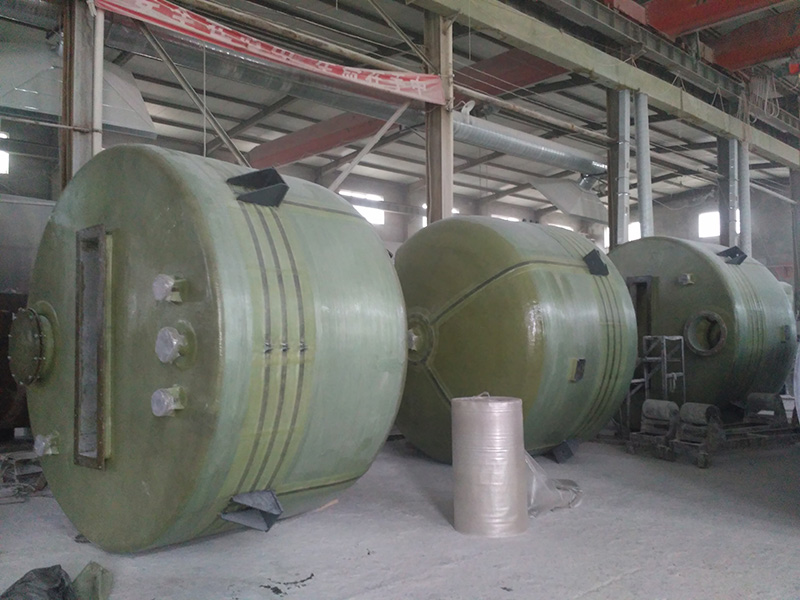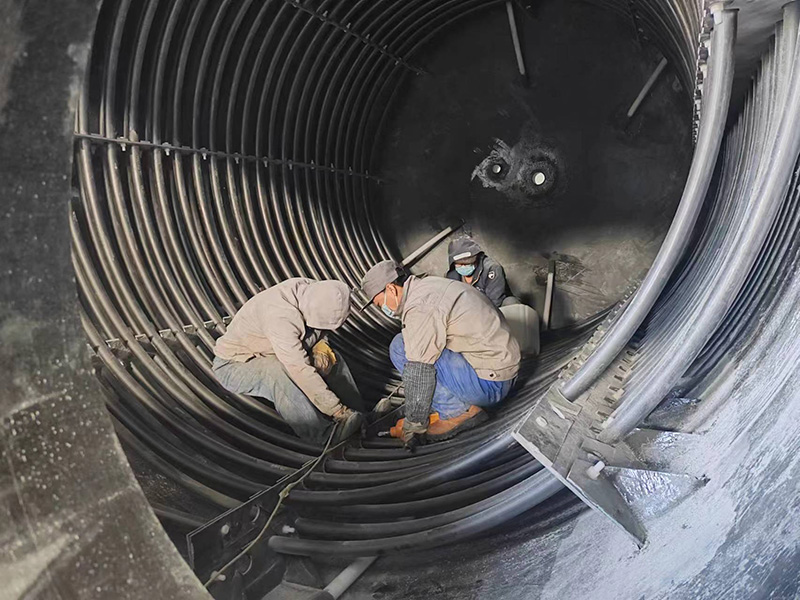1. Introduction to Reactor
The broad understanding of the reaction kettle (also known as reaction tank, reaction pot) is a container with physical or chemical reactions. The structural design and parameter configuration of the container are carried out according to the requirements of different process conditions, so as to realize the heating, evaporation, cooling and low-speed mixing reaction functions required by the process.
The FRP reactor is a comprehensive reaction vessel, and different designs are adopted for the structure, function and configuration accessories of the reactor according to the reaction conditions. Through stirring, heating and cooling, various materials are dispersed and mixed to carry out reaction polymerization. From the initial feed, reaction to discharge, the preset reaction steps can be completed with a high degree of automation, and the temperature, pressure, mechanical control (stirring, blasting, etc.), reactants can be controlled during the reaction process Important parameters such as / product concentration are strictly regulated.
Depending on the medium, working pressure, working temperature, and production process, the design structure and parameters of the glass fiber reinforced plastic reactor are also different, that is, the structural style of the reactor is different, and it belongs to non-standard container equipment. Production must be processed and tested in strict accordance with the corresponding standards to meet the technological needs of different working environments such as acid and alkali resistance, high temperature resistance, wear resistance, and corrosion resistance.
FRP reactors are widely used in petroleum; chemical; rubber; pesticides, pharmaceutical intermediates; dyestuffs and other production users to complete hydrolysis, neutralization, crystallization, distillation, evaporation, vulcanization, nitration, hydrogenation, alkylation, polymerization, condensation , heating mixing, constant temperature reaction and other chemical processes and many processes of intermediates. Its excellent anti-corrosion performance can resist most concentrations of acids, alkalis, salts, strong oxidants and other strong corrosive chemical media. Such as reactors, reaction pots, decomposition pots, polymerization pots, etc.;
2. The structure of FRP reactor:
FRP reactor is composed of kettle cover, kettle body, transmission device, sealing device, safety device, stirring device, heating device, cooling device, support and so on.
1. Kettle lid and kettle body: the whole is made of high-strength glass fiber reinforced plastic at one time, with high strength, no bursting, no leakage, corrosion resistance and high temperature resistance.
2. Transmission device: Cycloidal pin gear reducer, spiral bevel gear reducer, stepless variable speed reducer or frequency conversion speed regulation can be used, which can meet the special response requirements of various materials. The gear reducer should be used when the speed exceeds 160 rpm.
3. Sealing device: It is usually sealed with a stuffing box under normal or low pressure conditions, and the general working pressure is less than 2 kg. Mechanical seals are used under general medium pressure or vacuum conditions, and the general pressure is negative pressure or 4 kg. The mechanical seal will increase the cooling water jacket above 120 °C.
4. Safety device: Safety valve or bursting disc can be used or a combination of both can be used.
5. Stirring device: Generally, there are anchor type, frame type, paddle type, combined type, etc. When the height and diameter of the stirring device are relatively large, multi-layer stirring blades can be used, and it can also be optionally selected according to user requirements.
6. Heating device: The inner wall of the kettle is heated by graphite coil, stainless steel coil, alloy coil or glass steel pipe; heating methods include hot water, steam, heat transfer oil circulation heating, etc.
7. Cooling device: The inner wall of the kettle is cooled by graphite coils, stainless steel coils, alloy coils or stirring blades. Cooling methods include refrigerated circulating water, liquid ammonia, cold brine cooling, etc.
8. Support: There are leg support or ear support, etc. the
3. Advantages of glass fiber reinforced plastic reactor:
1. Great flexibility in product design and excellent structural performance.
2. The overall equipment is all made of high-strength FRP at one time. Compared with similar glass-lined (enamel) reactors, it is not afraid of bumps, and permanently eliminates the delamination, bulging, and cracks of porcelain and FRP caused by heating and cooling too fast. Leakage phenomenon, prolong the service life of equipment, reduce capital investment and loss for users in equipment maintenance, disassembly, replacement, production stoppage and so on.
3. The thermal conductivity of FRP is only 0.5 of that of commonly used metal materials. It is a good thermal and electrical insulator, and the equipment does not need additional insulation.
4. Light in weight and high in strength, the equipment is easy to maintain in the later period and the cost is low. During the maintenance period, there is almost no need to disassemble and stop production.
4. Specifications for operation
FRP reactor is a kind of reaction equipment, which must be paid attention to during operation, otherwise it will cause damage to the equipment and cause the production to be forced to stop. The operation of the FRP reactor should pay attention to the following aspects:
First, the reactor must be operated in strict accordance with the rules and regulations.
Secondly, before operation, you should carefully check whether there is any abnormality. During normal operation, do not open the upper cover or touch the terminals on the board to avoid electric shock; it is strictly forbidden to operate under pressure; during the pressure test with nitrogen, carefully observe the pressure When the test pressure is reached, close the nitrogen valve switch immediately; pressurization should be carried out slowly, especially the stirring speed should be increased slowly.
Finally, when the open steam in the kettle is heated, the material must flow through the vent hole of the heating pipe to avoid damage to the equipment due to excessive temperature exceeding the design temperature; at the same time, the reactor should be maintained after use, so that the pressure kettle can have a longer service life .
5. Use and maintenance
(1) Installation location: The pressure reactor should be installed in a high-pressure operating room that meets the explosion-proof requirements. When multiple reactors are equipped, they should be placed separately, and each two should be separated by a safe explosion-proof wall. Each operating room should have passages and outlets leading to the outside. When there are explosive media, the equipment should be well ventilated.
(2) After opening the package, check whether the equipment is damaged, install the equipment according to the structure diagram according to the equipment model, and check the equipped parts according to the packing list.
(3) The installation and sealing of the kettle body and the kettle cover: the kettle body and the kettle cover are contacted by gaskets, and they are pressed against each other by tightening the main nut to achieve a good sealing effect. When tightening the nut, it must be diagonally symmetrical, and tightened repeatedly and gradually, with uniform force, and the lid of the kettle is not allowed to tilt to one side, so as to achieve a good sealing effect. When tightening the main nut, the specified tightening torque must not exceed the range of 40~120N.M to prevent the sealing surface from being crushed or overloaded. Special care should be taken on the sealing surface. Before each installation, wipe the upper and lower sealing surfaces with a cloth, and pay special attention not to touch the sealing surface of the kettle body and the kettle lid without scars. If operated properly, it can be used more than tens of thousands of times. After the sealing surface is damaged, it needs to be reprocessed and repaired to achieve good sealing performance. When removing the kettle cover, the kettle cover should be slowly lifted up and down to prevent the sealing surfaces between the kettle body and the kettle cover from colliding with each other. If the seal is sealed with a gasket (PTFE, aluminum gasket, copper gasket, asbestos gasket, etc.), a good sealing effect can be achieved by tightening the main nut.
(4) Valves, pressure gauges, and safety valves are installed by tightening the positive and negative nuts to achieve the sealing effect. The circular arc sealing surfaces at the two ends of the connection must not rotate relative to each other. When assembling all screw connections, lubricants or Graphite blended with oil to avoid galling. The use of the valve: the needle valve is sealed with a wire. It only needs to turn the valve needle slightly to press the tight surface to achieve good sealing performance. Excessive force is prohibited to avoid damage to the sealing surface.
(5) After the equipment is installed, feed a certain amount of nitrogen gas to keep the pressure for 30 minutes, and check for leakage. If there is any leakage, please use soap foam to find the leakage point of the pipeline and nozzle. After finding out, release the gas and tighten it again. Introduce nitrogen to hold the pressure test to ensure that there is no leakage and start to work normally.
(6) When cooling down, chilled water or liquid ammonia can be used for internal cooling through the cooling coil to prevent excessive temperature difference stress during operation, causing cracks in the cooling coil. When the temperature in the kettle exceeds 100°C during operation, the water jacket between the magnetic stirrer and the lid of the kettle should be filled with cooling water to ensure that the water temperature is less than 35°C to avoid demagnetization of the magnetic steel.
(7) Safety device: It adopts positive arched metal bursting disc, made of stainless steel, manufactured according to the national standard GB567-89 "Technical Conditions for Arched Metal Blasting". It has been tested before leaving the factory and cannot be adjusted at will. If it has been blasted, it needs to be replaced again. The replacement period is determined by the user unit according to the actual situation of the unit. For those that exceed the bursting pressure of the bursting disc but have not burst, it should be replaced. Frequent use is best not to exceed 80% of the lower limit pressure of the bursting disc. When replacing It should be noted that the convex side of the rupture disc faces upwards.
(8) After the reaction is completed, cool down first, and then release the gas in the kettle to the outside through the pipeline to reduce the pressure in the kettle to normal pressure. It is strictly forbidden to disassemble under pressure, and then loosen the main bolts and nuts symmetrically Remove, and then carefully remove the kettle cover (or raise the kettle cover) and place it on the bracket. Special attention should be paid to protecting the sealing surface during the cover removal process.
(9) Cleaning in the kettle: After each operation, use the cleaning solution to remove the residues on the kettle body and the sealing surface. It should be cleaned frequently and kept clean.

